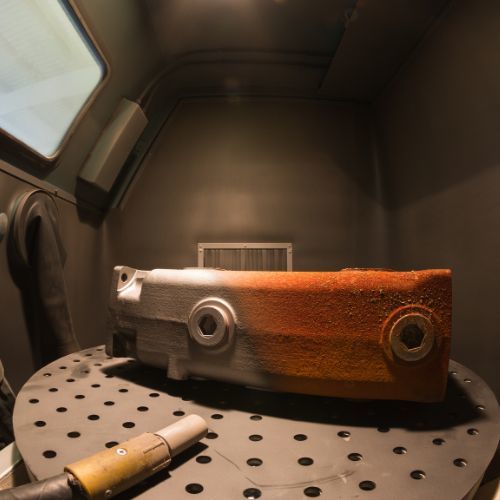Sandblasting is a very useful technique of surface preparation used before vehicle painting that eliminates old paint, corrosion, and other contaminants. Sandblasting will completely strip away everything from a frame or body panel down to the bare metal. But you may have wondered what type of sand do you use for sandblasting. There's a lot to answering that question, and we'll start by talking about beach sand, also known as silica sand.
What Type of Sand is Used in Sandblasting and Grit Blasting?
The word sand in sandblasting might bring to mind images of beach sand, complete with little seashells, being used to prep a metal surface for painting. And in the past that was more or less true. But today other materials are used in sandblasting. Let's take a look at why that is the case.
What Type of Sand do You Use for Sandblasting? In the Past it was Sand
In the past, silica sand was the most commonly used media for sandblasting. In the early days, when sandblasting was a new technology, they used what was readily available. Sand seemed the perfect choice. Just think about how much sand is at your local sand dune or beach. But there are a lot of problems with using silica sand. First it is porous, so it can hold moisture which makes the sand stick together and not flow well out of the blasting nozzle. It can also contain a lot of contaminants, such as the previously mentioned seashells and other living organisms from the beach. But all that pales in comparison to the biggest problem with silica sand, and that being that it can cause lung cancer. As the silica sand strikes the object being sandblasted at high speeds, it is pulverised into a fine dust that becomes airborne. It can get into people's clothes and ultimately be breathed into the lungs, which can lead to a disease called silicosis, as well as lung cancer. It is for these reasons that silica sand is no longer used as a sandblasting medium.
Modern Sandblasting Media
If silica sand is not used then what type of sand is used in sandblasting? It is called sandblasting, so you might be surprised to learn that sand is usually not used. Another name for sandblasting is grit blasting because there are many different blasting mediums other than sand that are popular. Here's a list of the most common types of sandblasting or grit-blasting mediums.
Glass Beads
Glass works very well as a sandblasting medium because it has a lot of similar properties to silica sand. This is probably because it is made from silica sand. However, in the process of making glass the silica changes in to a completely new molecular structure that is safe.
Aluminium Oxide
Aluminium oxide is a brown grain that looks very similar to sand. But it is much tougher, so it doesn't pulverise on impact the way that silica sand does. This also allows the aluminium oxide to be recycled through the sandblaster again and again.
Baking Soda
Sodium bicarbonate, also known as baking soda, is a popular choice for sandblasting due to it being cheap, readily available, and safe. It is one of the finer mediums on this list, so it is often used for finishing on softer materials like plastic.
Steel Grit
Steel grit is a very abrasive material that is useful for heavy jobs. It cuts through old paint and corrosion quickly and with ease. It will leave a smooth finish that can be ideal for vehicle panel work.
Steel Shot
These are little steel balls that come is various sizes. They are very tough, but they can leave a dimpled surface finish. This can be a desirable surface effect for a specific application, so if that is what you are going for then steel shot works great.
Walnut Shells
This is one of the most environmentally friendly options for a sandblasting medium. It is totally biodegradable and completely non-toxic. It also does a very good job as a blasting medium.
Which Blasting Medium do We Use?
What type of sand is used in sandblasting by the team at Revolution Paint & Panel in our sandblasting service? The answer is it depends on the kind of surface that we are working on, how much prep work that surface requires, and the final surface effect we are going after. We sometimes use more than one of the above-listed mediums when working on a truck or panel. That is often what is required to best prep for painting, and we always do the best work we can. Get in touch with us if you'd like to learn more about our services by calling us on (07) 3266 1387 or 0422 261 148, via email at enq@revolutionpaintpanel.com.au, or visit our store at 17-23 Business Drive, Narangba, QLD, 4504.

